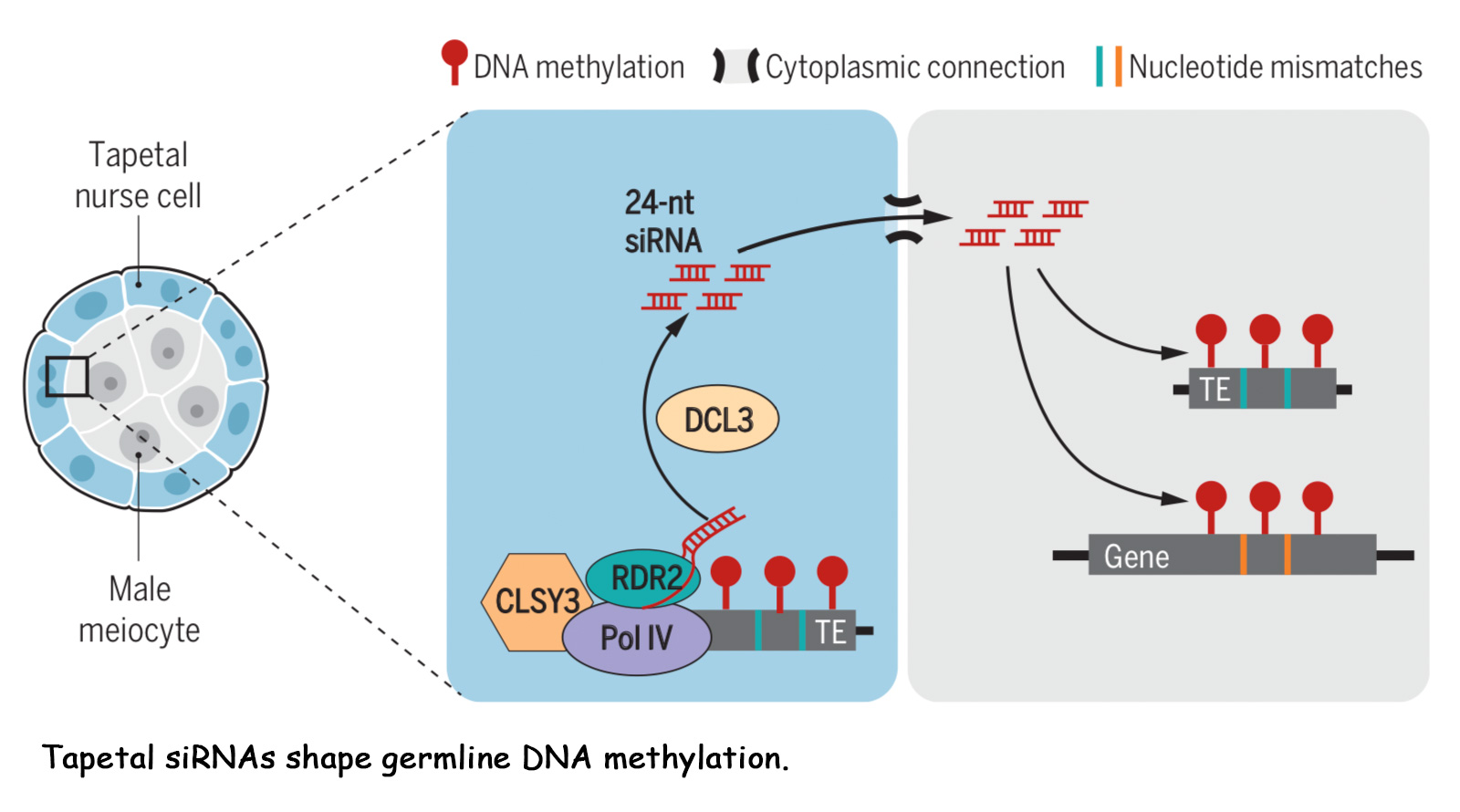博文
Science:拟南芥绒毛层产生的siRNAs决定了父本生殖细胞中的表观遗传
||
Nurse cell-–derived small RNAs define paternal epigenetic inheritance in Arabidopsis
第一作者:Jincheng Long
第一单位:John Innes Centre
通讯作者:Xiaoqi Feng
Introduction
Epigenetic modifications to chromatin, such as the methylation of DNA cytosines, carry regulatory information across the generations in plants and animals. Epigenetic marks are inherited through germlines, which can undergo epigenetic reprogramming that affects germline function. Mammalian germlines undergo genome-wide demethylation and remethylation, which resets epigenetic marks and restores cellular pluripotency. Germlines of flowering plants differentiate later than those of mammals and undergo distinct DNA methylation reprogramming. Global methylation level changes have been observed in plant germ cells, as well as local de novo methylation that regulates germline gene expression. However, the reprogramming mechanism remains unclear, which limits the understanding of tissue-specific and transgenerational epigenetic inheritance in plants.
引 言
动植物中,DNA胞嘧啶甲基化等染色质表观修饰携带有能够跨越世代的调控信息。表观标记通过生殖细胞系遗传,可以经历表观重编程,影响生殖细胞的功能。哺乳动物生殖细胞经历全基因组范围的去甲基化和再甲基化,进而重置表观标记,恢复细胞多能性。有花植物的生殖细胞要比哺乳动物的分化时间晚,并且经历了不同的DNA甲基化重编程。已有研究显示,植物的生殖细胞存在全局的甲基化水平变化,同时也存在局部的从头甲基化,从而调控生殖细胞基因的表达。但是,植物中表观重编程机制仍不清楚,限制了我们对于植物中组织特异性和跨代表观遗传的理解。
Rationale
Epigenetic modifications to chromatin, such as the methylation of DNA cytosines, carry regulatory information across the generations in plants and animals. Epigenetic marks are inherited through germlines, which can undergo epigenetic reprogramming that affects germline function. Mammalian germlines undergo genome-wide demethylation and remethylation, which resets epigenetic marks and restores cellular pluripotency. Germlines of flowering plants differentiate later than those of mammals and undergo distinct DNA methylation reprogramming. Global methylation level changes have been observed in plant germ cells, as well as local de novo methylation that regulates germline gene expression. However, the reprogramming mechanism remains unclear, which limits the understanding of tissue-specific and transgenerational epigenetic inheritance in plants. 原 理 动拟南芥雄株生殖细胞中基因的从头甲基化由小RNA指导的DNA甲基化通路RdDM来催化。RdDM使用一些从基因组上某些特定位点,比如转座子上转录的24核苷酸的小干扰RNA(siRNA),指导甲基转移酶甲基化基因组上的同源区。RdDM在植物细胞中普遍存在,通常会甲基化转座子区域。本文中,作者研究了生殖细胞中RdDM是如何靶向基因的,这种重编程是如何被局限于生殖细胞,以及如何选择数百个靶基因。
Results
We show that in Arabidopsis, germline-specific methylation at hundreds of genes is established by 24-nt siRNAs transcribed from hypermethylated transposons with imperfect sequence homology. CRISPR deletion of siRNA source transposons abolishes DNA methylation at corresponding genes in male meiocytes, demonstrating the ability of these siRNAs to target methylation in trans with mismatches. Furthermore, we found that meiocytes are quiescent in 24-nt siRNA biogenesis, and the gene targeting siRNAs are produced in tapetal nurse cells and transported into meiocytes. The siRNA profile of tapetal cells resembles that of meiocytes, suggesting bulk siRNA movement through the cytoplasmic channels (known as plasmodesmata) that connect these cells during early meiosis. Although gene-targeting siRNAs accumulate to levels in the tapetum comparable with those in meiocytes, the target genes are not methylated in the tapetum, showing that meiocytes can use imperfectly matching siRNAs to target DNA methylation. We also show that the biogenesis of gene-targeting siRNAs in the tapetum is driven by a putative chromatin remodeler, CLASSY3 (CLSY3). CLSY3 is absent in vegetative tissues but enriched in female and male organs. In male organs, CLSY3 is specifically expressed in tapetal cells. The clsy3 mutation eliminates de novo methylation at genes in male meiocytes as well as sperm, revealing the role of tapetal siRNAs in driving methylation reprogramming throughout the male germline. This conclusion was reinforced with experiments with a genetic mosaic system that restricted siRNA biogenesis to the tapetum. In the mosaic lines, tapetal siRNAs restore methylation in the male germline at genes specifically methylated in the germline and at transposons targeted by RdDM in all tissues. This shows that tapetal siRNAs shape the full spectrum of RNA-directed DNA methylation throughout the male germline, from meiocytes to sperm. As tapetal siRNAs induce methylation at transposons in the male germline, we investigated whether these siRNAs serve to silence germline transposons in addition to their gene regulatory function. We found that tapetal siRNAs methylate and prevent the expression of a Gypsy retrotransposon (GP1) that is specifically active in reproductive cells, demonstrating that tapetal siRNAs ensure germline genome integrity by suppressing transposons. 植物中,DNA胞嘧啶甲基化等染色质表观修饰携带有能够跨越世代的调控信息。表观标记通过生殖细胞系遗传,可以经历表观重编程,影响生殖细胞的功能。哺乳动物生殖细胞经历全基因组范围的去甲基化和再甲基化,进而重置表观标记,恢复细胞多能性。有花植物的生殖细胞要比哺乳动物的分化时间晚,并且经历了不同的DNA甲基化重编程。已有研究显示,植物的生殖细胞存在全局的甲基化水平变化,同时也存在局部的从头甲基化,从而调控生殖细胞基因的表达。但是,植物中表观重编程机制仍不清楚,限制了我们对于植物中组织特异性和跨代表观遗传的理解。 作者还发现绒毡层中,基因靶向的siRNA的生物合成是由一个假定染色质重塑因子CLSY3驱动的。CLSY3在营养组织中不存在,却富集于雌性和雄性器官中。再雄性器官中,CLSY3在绒毡层中特异性表达。clsy3突变体消除了雄性减数分裂细胞和精细胞中基因区的从头甲基化,说明绒毡层siRNAs在整个雄性生殖细胞中驱动甲基化重编程中的作用。作者进一步通过一个遗传镶嵌系统将siRNA生物合成局限在绒毡层的实验进一步验证了上述结论。镶嵌株系中,绒毡层siRNAs恢复了雄性生殖细胞中那些在生殖细胞中被特异性甲基化基因的甲基化,以及在所有组织中由RdDM靶向的转座子上的甲基化。这说明了绒毛层siRNAs塑造了包括减数分裂细胞和精细胞在内的雄性生殖细胞中RNA指导的DNA甲基化全图谱。 因为绒毛层siRNAs诱导雄性生殖细胞中转座子上的甲基化,作者进一步研究了这些siRNA在具有基因调控功能之外,是否还具有沉默生殖细胞转座子的功能。作者发现,绒毛层siRNAs甲基化并防止一个Gypsy逆转座子GP1的表达,该转座子在生殖细胞中特异性被激活,说明了绒毛层siRNAs通过抑制转座子,保证生殖细胞的基因组完整性。 Conclusion
Our work reveals the role of tapetum-derived 24-nt siRNAs in determining the paternal methylome. Tapetal siRNAs drive de novo methylation at genes in the germline and safeguard genome integrity by silencing transposons. The ability of meiocytes to use mismatched 24-nt siRNAs to induce methylation allows RdDM to target sequences similar to those of transposons that produce siRNAs in the tapetum. This should facilitate recognition and silencing of new transposons, indicating that meiosis is a key stage for genome surveillance and allows RdDM to specifically regulate germline gene expression. The broad targeting competence of tapetal siRNAs resembles that of metazoan gonad-expressed Piwi-interacting RNAs (piRNAs), suggesting convergent evolution of specialized small RNA pathways to control transposons and genes in plant and animal germlines. 结 论 本文的工作揭示了源自绒毛层24-nt siRNAs在决定父本甲基化组中的重要作用。绒毛层siRNAs驱动生殖细胞基因的从头甲基化,并通过沉默转座子来保证基因组的完整性。减数分裂细胞具有利用错配的24-nt siRNAs来诱导甲基化的能力,这使得其能够通过RdDM来靶向与绒毛层产生siRNAs的转座子相似的序列。这应该能够促进新转座子的识别和沉默,揭示了减数分裂是基因组监视的关键时期,允许RdDM来特异性调控生殖细胞基因的表达。绒毡层siRNAs的泛型靶向能力类似于后生动物性腺表达的Piwi互作RNA,即piRNAs,表明植物和动物生殖细胞中控制转座子和基因的特化小RNA途径存在趋同演化。

通讯作者
** Xiaoqi Feng **
个人简介: 牛津大学,博士; 加利福尼亚大学伯克利分校,博后。 研究方向:植物生殖细胞中的表观重编程。
doi: https://doi.org/10.1126/science.abh0556
Journal: Science
Published date: July 02, 2021
https://blog.sciencenet.cn/blog-3158122-1294047.html
上一篇:Current Biology:地钱DELLA具有类似于被子植物中协调生长与胁迫抗性的功能
下一篇:Nature Plants:袁隆平1930-2021
全部作者的其他最新博文
- • Plant Physiology:CsMADS3促进柑果中的叶绿素降解和类胡萝卜素合成(华中农业大学)
- • Molecular Plant:LBD11-ROS反馈调节作用于拟南芥的维管形成层增殖和次生生长(浦项科技大学)
- • Science Advances:根结线虫通过调控植物的CLE3-CLV1模块,促进侵染进程(日本熊本大学)
- • Nature Communications:油菜素内酯参与植物营养生长期转变的分子机制解析(浙江农林大学)
- • Current Biology:光合作用产生的蔗糖驱动侧根“生物钟”(德国弗莱堡大学)
- • PNAS:花同源异型基因在叶中被抑制、花中被激活的分子机制(南卡罗来纳大学)